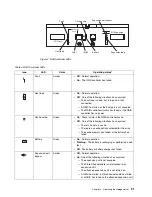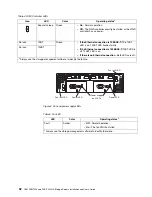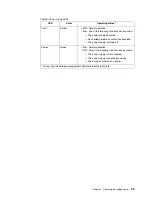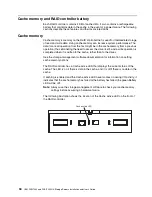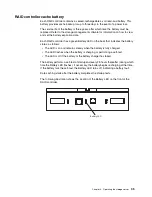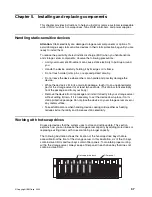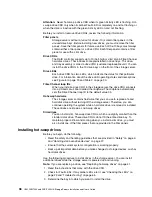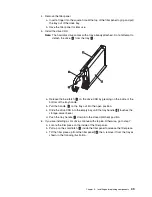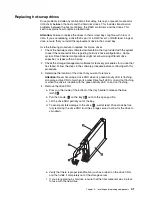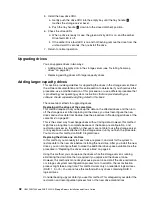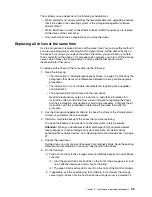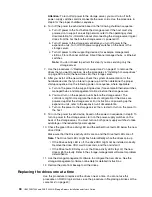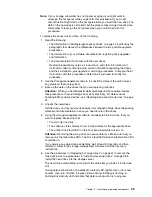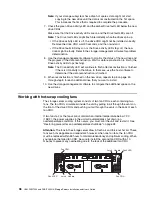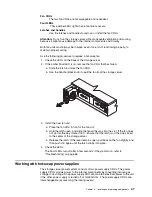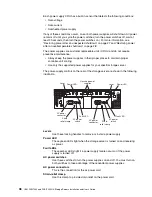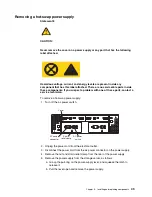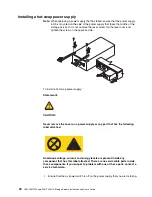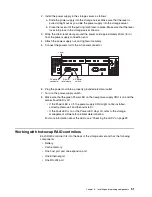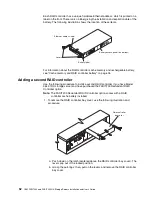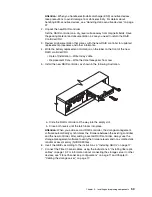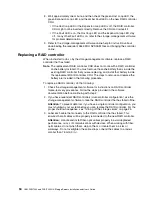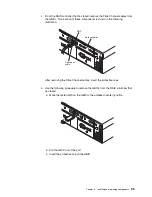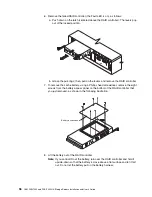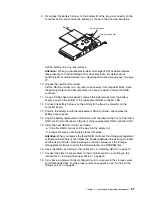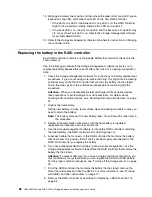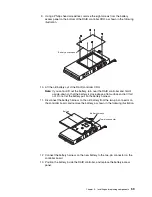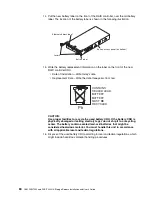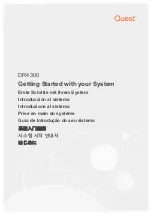
Chapter 5. Installing and replacing components
45
Note:
If your storage subsystem has hot spares assigned, you might want to
unassign the hot spares while you perform this procedure. If you do not,
reconstruction might start on the hot spare before you insert the new drive. The
data on the new drive is still rebuilt, but the process takes longer for each drive.
Remember to reassign the hot spares when you are finished with this
procedure.
To replace the drives one at a time, do the following:
1. Read the following:
• The information in “Adding larger-capacity drives” on page 42, particularly the
paragraphs that discuss the differences between the two possible upgrade
procedures.
• The information in your software documentation regarding drive upgrades
and installation.
• The documentation that comes with the new drives.
Read all precautionary notes, kit instructions, and other information. Kit
instructions often contain the most current information regarding the drives
and their installation, plus upgrade or servicing procedures. Compare the kit
instructions with this procedure to determine if you need to modify this
procedure.
2. Use the storage-management software to check the status of the unit. Correct
any problems that are reported.
3. Back up the data on the drives that you are replacing (optional).
Attention:
When you handle electrostatic discharge (ESD) sensitive devices,
take precautions to avoid damage from static electricity. For details about
handling ESD-sensitive devices, see “Handling static-sensitive devices” on page
37.
4. Unpack the new drives.
Set the drives on a dry, level surface away from magnetic fields. Save the packing
material and documentation in case you need to return the drives.
5. Using the storage-management software, manually fail the first drive that you
want to replace. Make sure that:
• You fail only one drive
• The software status display shows a failed status for the appropriate drive
• The amber Drive fault LED (on the front bezel below the drive) is on
Attention:
Removing the wrong drive can cause data loss. Make sure that you
remove only the failed drive CRU. The Drive fault LED below the failed drive CRU
should be on.
If you remove an active drive accidentally, wait at least 30 seconds and then
reinstall it. Refer to the storage-management software for further recovery
instructions.
6. Use the procedures in “Replacing hot-swap drives” on page 41 to remove the
failed drive. Use the procedures in “Installing hot-swap drives” on page 38 to
install the new drives into the storage server.
The new drive automatically reconstructs the data after you install it in the drive
slot.
During data reconstruction, the amber Drive fault LED might come on for a few
minutes, then turn off when the green Drive activity LED begins flashing. A
flashing Drive activity LED indicates that data reconstruction is in progress.
Summary of Contents for FAStT200 HA
Page 1: ...IBM IBM FAStT200 and FAStT200 HA Storage Servers Installation and User s Guide SC21 P877 50...
Page 2: ......
Page 3: ...IBM IBM FAStT200 and FAStT200 HA Storage Servers Installation and User s Guide SC21 P877 50...
Page 10: ...viii IBM FAStT200 and FAStT200 HA Storage Servers Installation and User s Guide...
Page 26: ...8 IBM FAStT200 and FAStT200 HA Storage Servers Installation and User s Guide...
Page 34: ...16 IBM FAStT200 and FAStT200 HA Storage Servers Installation and User s Guide...
Page 42: ...24 IBM FAStT200 and FAStT200 HA Storage Servers Installation and User s Guide...
Page 54: ...36 IBM FAStT200 and FAStT200 HA Storage Servers Installation and User s Guide...
Page 88: ...70 IBM FAStT200 and FAStT200 HA Storage Servers Installation and User s Guide...
Page 94: ...76 IBM FAStT200 and FAStT200 HA Storage Servers Installation and User s Guide...
Page 112: ...94 IBM FAStT200 and FAStT200 HA Storage Servers Installation and User s Guide...
Page 113: ......

